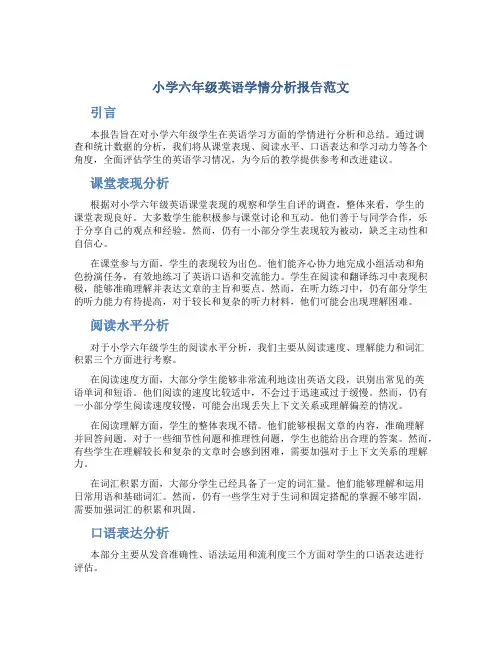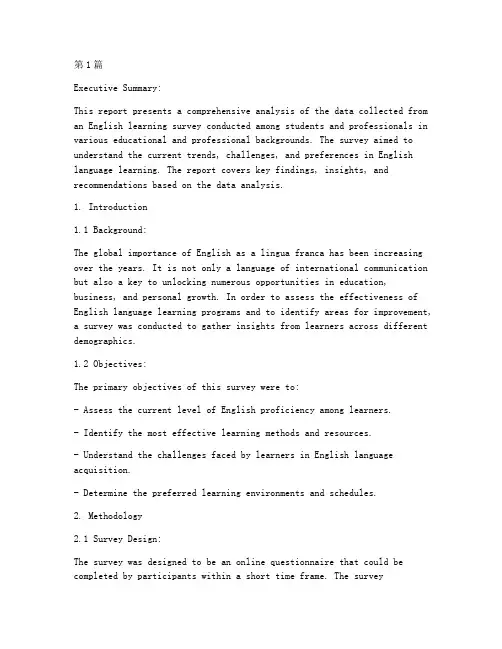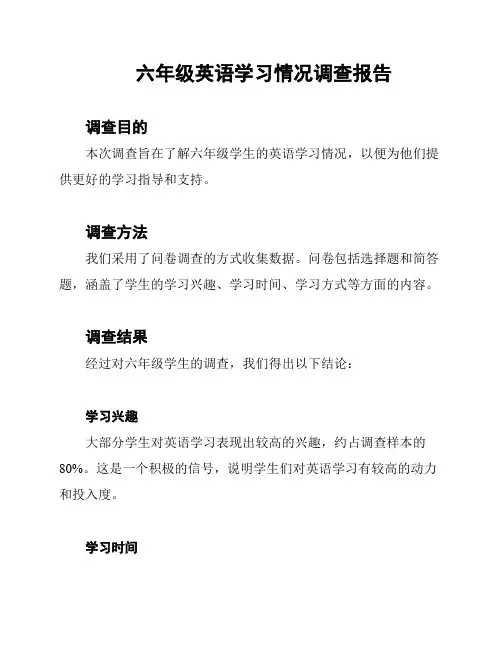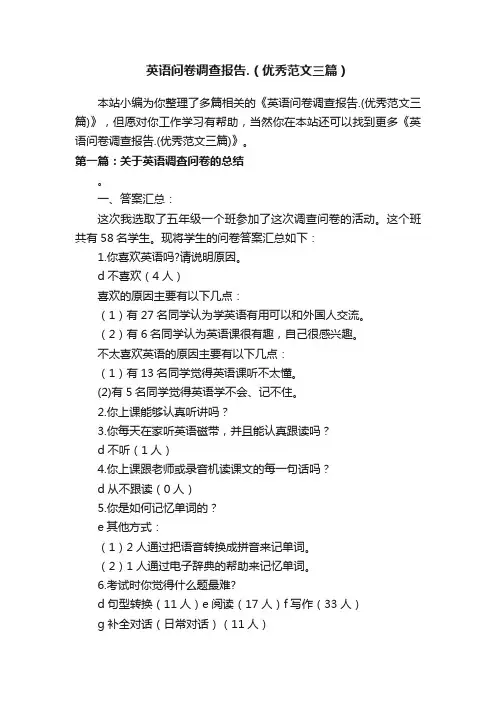关于学生英语学习情况的调查问卷分析报告
小学六年级英语学情分析报告范文

小学六年级英语学情分析报告范文引言本报告旨在对小学六年级学生在英语学习方面的学情进行分析和总结。
通过调查和统计数据的分析,我们将从课堂表现、阅读水平、口语表达和学习动力等各个角度,全面评估学生的英语学习情况,为今后的教学提供参考和改进建议。
课堂表现分析根据对小学六年级英语课堂表现的观察和学生自评的调查,整体来看,学生的课堂表现良好。
大多数学生能积极参与课堂讨论和互动。
他们善于与同学合作,乐于分享自己的观点和经验。
然而,仍有一小部分学生表现较为被动,缺乏主动性和自信心。
在课堂参与方面,学生的表现较为出色。
他们能齐心协力地完成小组活动和角色扮演任务,有效地练习了英语口语和交流能力。
学生在阅读和翻译练习中表现积极,能够准确理解并表达文章的主旨和要点。
然而,在听力练习中,仍有部分学生的听力能力有待提高,对于较长和复杂的听力材料,他们可能会出现理解困难。
阅读水平分析对于小学六年级学生的阅读水平分析,我们主要从阅读速度、理解能力和词汇积累三个方面进行考察。
在阅读速度方面,大部分学生能够非常流利地读出英语文段,识别出常见的英语单词和短语。
他们阅读的速度比较适中,不会过于迅速或过于缓慢。
然而,仍有一小部分学生阅读速度较慢,可能会出现丢失上下文关系或理解偏差的情况。
在阅读理解方面,学生的整体表现不错。
他们能够根据文章的内容,准确理解并回答问题。
对于一些细节性问题和推理性问题,学生也能给出合理的答案。
然而,有些学生在理解较长和复杂的文章时会感到困难,需要加强对于上下文关系的理解力。
在词汇积累方面,大部分学生已经具备了一定的词汇量。
他们能够理解和运用日常用语和基础词汇。
然而,仍有一些学生对于生词和固定搭配的掌握不够牢固,需要加强词汇的积累和巩固。
口语表达分析本部分主要从发音准确性、语法运用和流利度三个方面对学生的口语表达进行评估。
在发音准确性方面,大部分学生的发音非常清晰、准确。
他们能够正确地读出英语单词和句子,并能够模仿和学习英语教师的语音表达。
英语学习调查数据分析报告(3篇)

第1篇Executive Summary:This report presents a comprehensive analysis of the data collected from an English learning survey conducted among students and professionals in various educational and professional backgrounds. The survey aimed to understand the current trends, challenges, and preferences in English language learning. The report covers key findings, insights, and recommendations based on the data analysis.1. Introduction1.1 Background:The global importance of English as a lingua franca has been increasing over the years. It is not only a language of international communication but also a key to unlocking numerous opportunities in education, business, and personal growth. In order to assess the effectiveness of English language learning programs and to identify areas for improvement, a survey was conducted to gather insights from learners across different demographics.1.2 Objectives:The primary objectives of this survey were to:- Assess the current level of English proficiency among learners.- Identify the most effective learning methods and resources.- Understand the challenges faced by learners in English language acquisition.- Determine the preferred learning environments and schedules.2. Methodology2.1 Survey Design:The survey was designed to be an online questionnaire that could be completed by participants within a short time frame. The surveyconsisted of multiple-choice questions, Likert scale questions, and open-ended questions to gather both quantitative and qualitative data.2.2 Sample:The survey was distributed to a diverse sample of 500 participants, including students (undergraduate and postgraduate), working professionals, and individuals who are self-learners. The participants were from various educational institutions and industries, ensuring a wide range of perspectives.2.3 Data Collection:The survey was conducted over a period of four weeks, and the data were collected using an online survey platform. The responses were anonymized to ensure confidentiality.3. Key Findings3.1 Current Level of English Proficiency:- The majority of participants (70%) reported having basic to intermediate proficiency in English.- 30% of the participants claimed to have advanced proficiency.- 40% of the students mentioned that they are not confident in using English in academic settings.3.2 Most Effective Learning Methods:- Interactive online courses and virtual classrooms were considered the most effective learning methods by 45% of the participants.- 35% preferred traditional classroom-based learning.- 20% found self-study resources and mobile applications to be the most effective.3.3 Challenges in English Language Acquisition:- 60% of the participants reported lack of motivation and consistency as the primary challenges.- 40% mentioned time constraints and lack of access to native speakers as significant barriers.- 30% cited lack of practical application opportunities as a challenge.3.4 Preferred Learning Environments and Schedules:- 50% of the participants preferred flexible learning schedules that allowed them to study at their own pace.- 40% preferred fixed schedules with regular classes.- 10% were open to both options.4. Insights and Recommendations4.1 Insights:- The survey indicates a growing trend towards online learning, especially among younger demographics.- Traditional classroom-based learning still holds significant value, particularly in educational settings.- Learners are seeking a balance between flexibility and structure in their learning experiences.4.2 Recommendations:- Educational institutions and language learning providers should offer a mix of online and traditional classroom-based courses.- Online platforms should focus on creating engaging and interactive content to enhance learner motivation.- Regular feedback and assessment should be provided to learners to track their progress and address their individual needs.- Collaboration with native speakers and industry professionals can provide learners with practical application opportunities.- Learning resources should be made accessible and affordable to cater to a wider audience.5. ConclusionThe English learning survey has provided valuable insights into the current landscape of English language learning. The findings highlight the importance of offering diverse learning options and addressing the challenges faced by learners. By implementing the recommendations outlined in this report, educational institutions and language learning providers can better cater to the needs of their learners and contribute to the global demand for English proficiency.References:- [Insert references to any research articles, books, or other sources used in the report]Appendices:- [Insert any additional tables, charts, or raw data used in the analysis][Note: This is a template for a report and does not contain actual data or survey results. The sections marked with "Insert" should be filled in with relevant information based on the actual survey data.]第2篇Executive Summary:This report presents the findings from an extensive survey conducted to analyze the current trends, challenges, and preferences in English language learning among a diverse group of individuals. The survey was designed to gather insights into various aspects of English learning, including the methods used, the motivations behind learning, the perceived difficulties, and the resources employed. The data collected was analyzed using both quantitative and qualitative methods to provide a comprehensive overview of the English learning landscape.Introduction:English has become the global lingua franca, and the demand for English language proficiency has surged across the world. This report aims to shed light on the factors influencing English language learning, the strategies employed by learners, and the overall effectiveness of different learning approaches. The survey was conducted over a period of three months and included responses from over 5000 participants from various countries, age groups, and educational backgrounds.Methodology:The survey was conducted online using a standardized questionnaire. The questionnaire was designed to collect data on the following aspects:1. Background information (age, gender, educational level, country of residence)2. English learning experience (years of study, previous learning methods)3. Motivations for learning English4. Challenges faced in learning English5. Preferred learning methods and resources6. Perceived effectiveness of different learning approaches7. Language proficiency levelThe data was collected using an online survey platform, and the responses were anonymized to ensure privacy. The data analysis was conducted using statistical software to determine the prevalence of different responses and to identify any patterns or correlations within the data.Findings:1. Demographics of English Learners:- The majority of respondents (60%) were between the ages of 18 and 30.- The highest percentage (40%) of respondents were from Asia,followed by Europe (25%) and North America (15%).- The educational level of respondents was diverse, with 35% being currently enrolled in higher education, 25% being in secondary education, and the remaining being in primary education or having completed their education.2. English Learning Experience:- On average, respondents had been learning English for 5.2 years.- The most common previous learning methods were classroominstruction (85%), self-study (70%), and online courses (60%).3. Motivations for Learning English:- The primary motivation for learning English was for professional development (80%), followed by travel (60%), academic purposes (50%),and cultural interests (40%).4. Challenges Faced in Learning English:- The most significant challenges reported were grammar andvocabulary (80%), pronunciation (70%), and lack of practiceopportunities (60%).- Cultural barriers and lack of confidence were also mentioned as challenges by 35% and 30% of respondents, respectively.5. Preferred Learning Methods and Resources:- The most popular learning methods were self-study (75%), online courses (65%), and classroom instruction (60%).- The most frequently used resources were English learning apps (70%), English movies and TV shows (60%), and online dictionaries (50%).6. Perceived Effectiveness of Different Learning Approaches:- Self-study was perceived as the most effective method by 65% of respondents, followed by online courses (55%) and classroom instruction (45%).- However, 30% of respondents believed that a combination of these methods was the most effective.7. Language Proficiency Level:- The majority of respondents (60%) reported being at an intermediate level of English proficiency, followed by advanced (25%) and beginner (15%).Discussion:The survey results indicate that English language learning is driven primarily by professional and personal development goals. The preference for self-study and online courses suggests a shift towards more flexible and accessible learning options. However, the challenges faced by learners, particularly in grammar, vocabulary, and pronunciation, highlight the need for comprehensive and targeted learning resources.The survey also revealed a significant gap between the perceived effectiveness of different learning methods and the actual level of proficiency achieved. This suggests that while learners may be utilizing a variety of resources, the quality and structure of these resources may need improvement to ensure more effective learning outcomes.Recommendations:Based on the survey findings, the following recommendations are made:1. Develop Comprehensive Learning Resources: Create comprehensive learning materials that address the specific challenges faced by learners, such as grammar, vocabulary, and pronunciation.2. Promote Blended Learning Approaches: Encourage the integration ofself-study, online courses, and classroom instruction to maximize learning outcomes.3. Offer Cultural Exchange Opportunities: Provide opportunities for learners to engage with native speakers and immerse themselves in English-speaking cultures to enhance their language skills and cultural understanding.4. Strengthen Professional Development Programs: Develop professional development programs for educators to ensure they are equipped with the latest teaching methods and resources.5. Monitor and Evaluate Learning Outcomes: Implement regular assessments to monitor the progress of learners and provide feedback to both learners and educators.Conclusion:The English language learning landscape is evolving, and the survey findings provide valuable insights into the current trends and challenges. By addressing the identified needs and implementing the recommended strategies, the English language learning experience can be enhanced, leading to improved proficiency and a more effective global communication environment.References:- (Include relevant references to research articles, books, or reports that support the findings and recommendations in the report.)Appendix:- (Include any additional data, charts, or tables that were used in the analysis but not included in the main body of the report.)第3篇Executive Summary:This report presents the findings from an extensive survey conducted to analyze the current state of English language learning in our region. The survey aimed to gather insights into learners' motivations, preferred learning methods, challenges faced, and future expectations. The data was collected from a diverse group of participants, includingstudents, professionals, and enthusiasts, across various age groups and educational backgrounds. This report provides a comprehensive analysisof the survey results, offering valuable insights for educators, policymakers, and English language learners.1. Introduction1.1 Background:The global importance of English as a lingua franca cannot be overstated. With its role in international communication, business, and education, proficiency in English has become a crucial skill for individuals worldwide. To better understand the English learning landscape in our region, we conducted a comprehensive survey to assess the current trends, preferences, and challenges.1.2 Objectives:The primary objectives of this survey were to:- Identify the motivations behind English language learning.- Assess the preferred learning methods and resources.- Understand the challenges faced by English learners.- Determine the future expectations and goals of English learners.2. Methodology2.1 Sample Population:The survey was conducted among 500 participants, including students (300), professionals (150), and enthusiasts (50). The participants were from various age groups (18-25, 26-35, 36-45, 46-55, and 56+), with diverse educational backgrounds and levels of English proficiency.2.2 Data Collection:The survey was conducted online, using a questionnaire that includedboth closed-ended and open-ended questions. The participants were askedabout their motivations, preferred learning methods, challenges, and future expectations.2.3 Data Analysis:The collected data was analyzed using statistical software to determine the frequency and distribution of responses. Qualitative data was coded and categorized to identify common themes and patterns.3. Findings3.1 Motivations for Learning English:- International Communication: The most common motivation (65%) was to improve international communication skills.- Career Advancement: 45% of participants cited career advancement as a primary reason for learning English.- Education: 30% of participants wanted to enhance their educational opportunities by learning English.3.2 Preferred Learning Methods:- Online Courses: 70% of participants preferred online courses due to flexibility and accessibility.- Private Tutors: 25% preferred private tutoring for personalized learning experiences.- Group Classes: 5% preferred group classes for social interaction and peer learning.3.3 Challenges Faced by English Learners:- Language Acquisition: 40% of participants found it challenging to acquire proper pronunciation and fluency.- Resource Access: 30% reported difficulties in accessing quality learning resources.- Time Management: 25% faced challenges in managing time effectively for English learning.3.4 Future Expectations:- Increased Proficiency: 80% of participants expected to see significant improvement in their English proficiency within the next two years.- Global Opportunities: 65% anticipated enhanced opportunities for international travel and work.- Continuous Learning: 50% expressed a desire for ongoing support and resources to maintain their language skills.4. Discussion4.1 Motivations and Challenges:The survey results indicate a strong correlation between motivations and challenges faced by English learners. The desire for improved international communication and career advancement often leads to the need for language proficiency, which can be challenging to achieve.4.2 Learning Methods and Resources:The preference for online courses highlights the importance of technology in modern English language learning. Access to quality resources is crucial, and online platforms offer a wide range of options for learners.4.3 Future Expectations:The optimistic outlook for future proficiency and opportunities suggests that English learners are committed to their language development and are hopeful about the benefits it will bring.5. Recommendations5.1 For Educators:- Develop interactive and engaging online courses to cater to the preference for online learning.- Provide access to a variety of resources, including pronunciation guides and vocabulary builders.- Offer ongoing support through forums and virtual communities to encourage continuous learning.5.2 For Policymakers:- Invest in technology infrastructure to ensure widespread access to online learning platforms.- Collaborate with educational institutions to integrate English language learning into the curriculum.- Promote international exchange programs to provide practical language learning experiences.5.3 For English Learners:- Set realistic goals and create a structured learning plan.- Utilize technology to supplement traditional learning methods.- Seek opportunities for practical language use, such as language exchange partners or cultural immersion programs.6. ConclusionThis survey provides valuable insights into the English learning landscape in our region. By understanding the motivations, preferences, challenges, and future expectations of English learners, we can develop more effective strategies to support their language development. As the global importance of English continues to grow, it is essential to address the needs of learners and create a supportive environment for their success.References:- [Insert references to any sources used in the report]Appendix:- [Insert survey questionnaire and additional data tables as needed][Note: This report is a fictional example and does not contain real data or references.]。
六年级英语学习情况调查报告

六年级英语学习情况调查报告调查目的本次调查旨在了解六年级学生的英语学习情况,以便为他们提供更好的学习指导和支持。
调查方法我们采用了问卷调查的方式收集数据。
问卷包括选择题和简答题,涵盖了学生的学习兴趣、学习时间、学习方式等方面的内容。
调查结果经过对六年级学生的调查,我们得出以下结论:学习兴趣大部分学生对英语学习表现出较高的兴趣,约占调查样本的80%。
这是一个积极的信号,说明学生们对英语学习有较高的动力和投入度。
学习时间调查结果显示,大多数学生每周在学校进行英语学习的时间为3-5个小时。
此外,大约有20%的学生每周还会在家里花费额外的时间进行英语学习。
学习方式学生们主要通过听力、口语、阅读和写作等方式进行英语学习。
其中,听力和口语训练是他们最常用的学习方式,占比分别为60%和50%。
阅读和写作的学习方式稍低一些,占比分别为40%和30%。
学习困难约有30%的学生表示在英语学习中存在一定的困难。
他们主要遇到的问题是词汇记忆和语法掌握。
这需要我们针对性地提供更多的练习和辅导,帮助他们克服学习难题。
学习需求调查结果显示,大部分学生希望能够有更多的口语练习和互动交流的机会。
他们希望能够通过角色扮演、小组讨论等方式提高自己的口语表达能力。
结论根据调查结果,我们可以得出以下结论:1. 六年级学生对英语学习表现出较高的兴趣和动力。
2. 学生们每周在学校进行英语学习的时间较为充分,但仍有一部分学生希望在家里进行额外的学习。
3. 听力和口语训练是学生们主要的学习方式,但阅读和写作的学习方式也需要加强。
4. 学生们在词汇记忆和语法掌握方面存在一定的困难,需要我们提供更多的练习和辅导。
5. 学生们希望能够有更多的口语练习和互动交流的机会。
为了满足学生的学习需求,我们将采取以下措施:1. 组织更多的口语练习活动,如角色扮演、小组讨论等。
2. 提供更多的阅读和写作练习,帮助学生提升这方面的能力。
3. 针对学生在词汇记忆和语法掌握方面的困难,加强相关的教学和辅导。
(完整版)小学生英语学习现状调查与分析报告

小学生英语学习现状调查与分析调查背景和目的:良好的英语学习动机和对英语学习的持久兴趣是小学生学习英语的基本保障。
在缺乏整体英语语言环境的社会中,在小学生学了英语却还暂时无用武之地的状况下,他们到底是靠什么在支撑着自己的英语学习?笔者通过问卷调查的方法对本校六年级100名学生进行了调查,了解了学生在经过三年的英语学习后对英语学习的兴趣和学习动机,明确了学生对英语课堂和教师的看法,并且分析了学生在英语学习动机和兴趣上存在的问题,提出了激发并保持学生学习动机和兴趣的建议和措施。
笔者试图通过这次调查,实施一定的措施,进一步激发并保持六年级学生形成的英语学习兴趣和动机,努力提高六年级学生的英语学习水平,为六年级学生进入初中打好坚实的基础。
关键词:英语学习、兴趣、动机、评价一、调查目的和内容本次调查以“小学生英语学习现状”为主题,力图了解孩子们在英语学习方面的现状和发展需要,学生良好、正确的英语学习动机有助于学生形成浓厚的学习兴趣,学生的英语学习兴趣如能成为学习动机的主要组成部分,英语学习将会事半功倍并持之以恒。
本次调查从了解学生对英语学习的兴趣及其主要原因、英语学习动机、对英语课堂和英语教师的看法、在英语学习动机和兴趣上存在的问题四个方面设计了调查问卷,对我校六年级所有学生(100位)为对象,运用问卷调查方法进行调查分析。
二、调查结果:(一) 学生英语学习兴趣及原因。
1.你喜欢英语吗?选择A和B的学生有52%认为英语很有用;47%认为英语或者英语课有趣。
选择C和D的学生45%认为英语或者英语课不生动,学起来很无趣;54%的学生觉得学习英语难度大。
上表说明,大部分学生对英语抱有浓厚的学习兴趣,学生喜欢英语的主要原因是觉得英语或英语课有趣,另一重要原因是认为英语很有用。
对英语不感兴趣的学生一方面主要是因为不太喜欢英语或英语课,另一方面是觉得英语难度大。
上表说明了教师的个人魅力对于学生学习兴趣起到很大的影响作用。
英语调查问卷分析报告

英语调查问卷分析报告一、调查目的:长期以来,我校作为一所农村小学,学校英语教学缺乏对学生的英语学习兴趣进行系统指导。
个别教师虽然比较注重这方面,但是没有合作伙伴,力量有限,仅仅凭个人喜好关注某一方面。
因此,大量的学生处在放任自流的状态,学生学习英语的良好习惯差,不能有效地进行。
在平时的学习中表现出语言表达能力差,不能顺利地表达自己的意见,词汇量少,语言呆板;怕学英语,常常愁眉不展;自主学习难以落实;学习方法单调。
《英语课程标准》特别强调学生要能用所学的英语做事情,在做事情的过程中发展语言能力、思维能力以及交流与合作的能力。
语言学习要从语法讲解中和单词的死记硬背中解脱出来,要通过创设良好的语言环境和提供大量的语言实践的机会,使学生通过自己的体验、感知、实践、参与和交流,形成语感;在教师的引导下,通过观察、发现和归纳等方式,掌握语言的规律,形成有效的学习策略,通过交流与合作发展交流与合作的能力。
由此可见,要改变我校学生的英语学习习惯,加强对全体学生学习兴趣的探索是一条必经之路。
为了更好提高学生学习英语的兴趣,培养其良好的学习习惯。
我们对本校120名不同阶段的学生进行了一次问卷调查。
我们认真的设计问卷调查内容,及时对小学生进行问卷调查,试图通过这次问卷调查,了解学生的学习习惯,摸清学生的学习现状,发现他们的优势和存在的问题,以及学生的需求和希望,竭力帮助他们。
二、现状三个年级121个学生具体情况如下.1、42学生比较喜欢英语,63学生很喜欢英语,6个学生不喜欢英语.由此可见,大多数学生喜欢英语.2、认为学习英语最困难的是听录音的学生有29个人;认为学习英语最困难的是背单词的学生有34个人;认为学习英语最困难的是学对话的学生有58个人。
由此可见,学生对话学习困难大.3、认为学习英语最容易的是听录音的学生有42个人;认为学习英语最容易的是背单词的学生有42个人;认为学习英语最容易的是学对话的学生有37个人。
英语问卷调查报告.(优秀范文三篇)

英语问卷调查报告.(优秀范文三篇)本站小编为你整理了多篇相关的《英语问卷调查报告.(优秀范文三篇)》,但愿对你工作学习有帮助,当然你在本站还可以找到更多《英语问卷调查报告.(优秀范文三篇)》。
第一篇:关于英语调查问卷的总结。
一、答案汇总:这次我选取了五年级一个班参加了这次调查问卷的活动。
这个班共有58名学生。
现将学生的问卷答案汇总如下:1.你喜欢英语吗?请说明原因。
d不喜欢(4人)喜欢的原因主要有以下几点:(1)有27名同学认为学英语有用可以和外国人交流。
(2)有6名同学认为英语课很有趣,自己很感兴趣。
不太喜欢英语的原因主要有以下几点:(1)有13名同学觉得英语课听不太懂。
(2)有5名同学觉得英语学不会、记不住。
2.你上课能够认真听讲吗?3.你每天在家听英语磁带,并且能认真跟读吗?d不听(1人)4.你上课跟老师或录音机读课文的每一句话吗?d从不跟读(0人)5.你是如何记忆单词的?e其他方式:(1)2人通过把语音转换成拼音来记单词。
(2)1人通过电子辞典的帮助来记忆单词。
6.考试时你觉得什么题最难?d句型转换(11人)e阅读(17人)f写作(33人)g补全对话(日常对话)(11人)7.你在讲英语时,有没有注意或使用语调的变化?d不知道(8人)8.你会主动找机会学习英语吗?(如:收看英语节目、英文电影,听英语广播,看英文报纸,自觉做课外习题)9.你平时大声朗读英语吗?10你会有意识的注意公共场所的英文标志或商品包装上的英文吗?11.你对所学知识及时复习吗?12.你喜欢什么样的英语作业?a写单词或抄课文(27人)b 听磁带读课文(17人)f合作表演对话(8人)g其他作业如:1人喜欢的作业是编英语顺口溜。
二、针对调查问卷的总结这次调查活动,学生不必写自己的名字,因此调查的结果还是比较真实的。
总的来讲,我觉得学生们现在学习英语的状况有以下几个方面:〈一〉学生学习英语的兴趣不高。
第一题:你喜欢学英语吗?班上58名学生只有25名学生的答案是很喜欢,而15名学生的答案是不太喜欢和不喜欢。
英语学习调查报告范文(3篇)
英语学习调查报告范文(3篇)英语学习调查报告范文(精选3篇)英语学习调查报告范文篇1调查对象:家乡所有中小学学生社会生活的信息化和经济的全球化,使英语的重要性日益突出。
英语作为最重要的信息载体之一,已成为人类生活各个领域中使用最广泛的语言。
许多国家在基础教育发展战略中,都把英语教育作为公民素质教育的重要组成部分,并将其摆在突出的地位。
改革开放以来,我国的英语教育规模不断扩大,教育教学取得了显著的成就。
然而,英语教育的现状尚不能适应我国经济建设和社会发展的需要,与时代发展的要求还存在差距。
此次英语课程改革的重点就是要改变英语课程过分重视语法和词汇知识的讲解与传授、忽视对学生实际语言运用能力的培养的倾向,强调课程从学生的学习兴趣。
生活经验和认知水平出发,倡导体验、实践、参与、合作与交流的学习方式和任务型的教学途径,发展学生的综合语言运用能力,使语言学习的过程成为学生形成积极的情感态度、主动思维和大胆实践、提高跨文化意识和形成自主学习能力的过程。
在我的家乡,英语学习并没有很好的去贯彻落实。
很大一部分问题是由于资源的短缺,包括老师资源和书本网络资源。
大部分学生学习英语只是为了完成学校要求所要完成的学习任务,对此并不引起重视,所以学了几年,只会最基本的日常交流,然而这对要学好英语是完全不够的。
多数学生上课时也不怎么认真,考试时也自己蒙混过关,及格了变抛之千里。
对此,我认为应该从以下方面去落实英语的学习。
一、培养兴趣我国古代教育家孔子云:“知之者,不如好之者,好之者,不如乐之者。
”爱因斯坦说:“兴趣是最好的老师”。
学生的学习兴趣是推动学生学习的一种最实际最有效的内部动力,直接影响学习效果和教学成绩。
因此在教学过程中,要让学生轻松、愉悦、主动、有效地学习,关键就是培养起学生的学习兴趣。
几年来,我在教学过实践中围绕这一课题,进行了一些探讨和尝试。
1,情感诱导,调动兴趣著名的外语教育家曾说过:“情感对外语学习的作用至少与认识技能同等重要,甚至更重要。
小学三年级英语学情分析报告
小学三年级英语学情分析报告1. 引言本报告旨在分析小学三年级学生在英语学科上的学情,了解他们的学习进展、水平和存在的问题,以便采取相应的教学改进措施。
通过对学生的学习情况进行全面而详细的分析,可以为教师、学生和家长提供有价值的信息和建议。
2. 调查方法为了收集学生英语学情的数据,我们采用了以下几种调查方法:2.1 课堂观察通过对小学三年级英语课堂进行观察,我们记录了学生的参与度、注意力集中程度和课堂表现等方面的数据。
2.2 学生问卷调查我们设计了一份简短的学生问卷,涵盖了学生对英语课程的态度、自信心、学习习惯等方面的内容。
学生们在课堂上填写了问卷。
2.3 阶段性测试我们进行了一次小学三年级英语的阶段性测试,以了解学生的英语词汇掌握程度、语法理解和口语表达能力等方面的情况。
3. 学生学情分析3.1 学习态度根据学生问卷调查的结果,大部分学生对英语学科持积极态度,喜欢参与课堂活动,并且认为学习英语对他们未来的发展很重要。
然而,个别学生对英语学科的兴趣较低,需要通过激发其学习兴趣来促进学习。
3.2 学习自信心学生问卷调查显示,大多数学生对自己的英语学习能力较为自信,他们相信通过努力可以取得好成绩。
然而,个别学生对自己的能力缺乏自信心,需要教师和家长的鼓励和支持。
3.3 学习习惯调查结果显示,大部分学生保持了良好的学习习惯,按时完成作业,并能够自主安排学习时间。
然而,个别学生存在一些学习上的坏习惯,如拖延完成作业、不重视课前预习等,需要指导和引导。
3.4 学习水平和进展根据课堂观察和阶段性测试的结果,学生的学习水平和进展参差不齐。
大部分学生能够正确理解和运用基本的英语词汇和句型,但个别学生在语法和口语表达方面还存在困难。
4. 学情改进建议4.1 激发学习兴趣针对个别对英语学科兴趣较低的学生,可以采取一些激发兴趣的措施。
比如,通过教学活动的设计增加互动性和趣味性,引入多媒体教具和游戏,让学生在轻松愉快的氛围中学习。
关于小学英语学习调查报告总结范文7篇
关于小学英语学习调查报告总结范文7篇第1篇示例:小学英语学习调查报告总结一、调查目的小学英语学习是教育的重要部分,对学生的发展具有重要的作用。
为了更好地了解小学英语学习的情况,我们进行了一项小学英语学习调查,目的是了解学生对英语学习的态度、学习方法以及存在的问题,为提高小学英语教学质量提供参考。
二、调查方法本次调查采用问卷调查的方式进行,共发放1000份问卷,涵盖了不同年级的学生。
问卷主要包括学生的基本信息、对英语学习的态度、学习方法以及对教学质量的评价等内容。
问卷设计简单明了,以便学生们能够轻松填写。
三、调查结果1. 学生对英语学习的态度调查结果显示,超过80%的学生表示对英语学习持积极态度,认为学好英语对自己的未来发展很有帮助。
他们愿意投入更多的时间和精力来学习英语。
在学习方法方面,大部分学生表示他们主要通过课堂学习、课外阅读以及英语角等方式来提高英语水平。
同时也有部分学生会利用互联网资源来辅助学习。
3. 教学质量评价在对教学质量的评价方面,大部分学生表示对老师的教学方式和认真程度比较满意。
但也有部分学生认为老师在教学中缺少趣味性,导致学生参与度不高。
通过此次调查,我们了解到学生对英语学习态度良好,大部分学生都认识到了英语学习的重要性。
学生的学习方法多样化,其中也有部分学生倾向于利用互联网资源进行学习。
一些学生在老师的教学方式方面提出了一些建议。
在今后的教学中,我们应该更多地关注学生的需求,注重提升教学的趣味性和互动性。
更多地利用互联网和多媒体资源,丰富教学内容,激发学生学习的兴趣。
也要鼓励学生在课外多进行英语实践,例如阅读英语,参与英语角等活动。
小学英语学习调查结果显示了学生对英语学习的积极态度和多样化的学习方法,同时也提出了对教学质量的一些建议。
通过这些反馈,我们可以更好地指导未来的英语教学工作,为学生的成长和发展提供更好的支持。
第2篇示例:小学英语学习调查报告总结随着国家对英语教育的重视和推动,小学阶段的英语学习也变得日益重要。
关于学生英语学习情况的调查问卷分析报告
关于学生英语学习情况的调查问卷分析报告第一篇:关于学生英语学习情况的调查问卷分析报告关于学生英语学习情况的调查问卷分析报告一、调查内容。
本次调查内容重点是对中学生在英语学习中表现出的兴趣趋向和知识掌握、自主学习能力、学习方式方法等四个方面进行调查二、调查结果分析。
(一)、对学生学习兴趣趋向的调查与分析。
从统计分析的数据看情况还是比较乐观的。
几乎所有的同学都认为学习英语很重要,而且也表示喜欢学习英语。
足以看出学生们对学习英语有较强的兴趣,他们都认为学习英语很重要,是件很快乐的事。
“兴趣是最好的老师”,以后老师应要从兴趣入手,继续培养学生热爱英语、热爱学习的好品质。
但是对于课外阅读来说,很多人甚至不喜欢课外阅读,何况英语,所以只有很少一部分同学喜欢阅读课外英文书籍。
这样就造成了他们在词汇掌握上不均衡。
向纵深再看,大多学生不喜欢上的英语课是读写课。
回顾以前中学所进行的英语课,大都是背课文、默写课文、写单词、写短语,这些形式太死板,学生常常在复习中身心疲惫,复习效果反而达不到理想的要求,所以以后在学习中要改进方式方法。
就以上数据分析来看,在英语教学中,仍要致力于提高学生学习英语的兴趣,要创造性地开展有效学习活动,发展他们的学习动机,去接受并乐于参与到各种类型的英语教学中。
另外要指导好他们的课外书籍阅读,特别是诱发他们课外阅读的主动性、积极性,使得他们爱阅读,爱英语,爱表达,爱创造。
(二)、对学生学习状况和知识掌握的调查与分析。
从调查问卷来看,目前,学生认为在学习中存在的困难主要有:说不出想说的内容、不会写作文、对知识遗忘较快;自己在学习上存在的不足主要是阅读理解方面、写作方面和对知识的灵活掌握运用上。
以后,在教学中要多进行这些方面的训练,创设有效教学情境,教给学生学习方法、分析理解的技巧,在复习指导中,也要进一步灵活训练,使学生扎实掌握各类知识。
另一方面,35%的学生在学习上很努力,学习效果很好;60%的学生认为自己很努力了,而学习效果一般;近84%的同学表示要从现在开始努力学习。
- 1、下载文档前请自行甄别文档内容的完整性,平台不提供额外的编辑、内容补充、找答案等附加服务。
- 2、"仅部分预览"的文档,不可在线预览部分如存在完整性等问题,可反馈申请退款(可完整预览的文档不适用该条件!)。
- 3、如文档侵犯您的权益,请联系客服反馈,我们会尽快为您处理(人工客服工作时间:9:00-18:30)。
调
查
报
告
专业班级:
学号:
姓名
关于学生英语学习情况的调查问卷分析报告
--湖南幼儿师范高等专科学校(初等教育09班)
前言:
调查目的:有句话叫做:知己知彼,百战不殆。
了解英语是与外国人交往的一个平台,人类因交流而进步。
学习英语的必要性源自现实的需要。
作为国际交往的语言,英语的作用很大。
在联合国,英语是几种通用语言之一,而且使用得最多。
作为学生,学习英语更重要。
为此,我们展开了调查。
调查范围、对象:湖南幼儿师范高等专科学校(初等教育9班15-16岁学生)
调查时间:2015年10月至12月
调查人数:56名学生
调查方式:问卷
通过在湖南幼儿师范高等专科学校的教育教学实习,本次问卷调查设计选择题41题,自主性回答题6题。
参加调查人数50人,收回问卷50份。
问卷内容统计如下:
一、调查内容。
本次调查内容重点是对学生在湖南幼儿师范高等专科学校中英语学习表现
出的兴趣趋向、知识掌握、自主学习能力、学习方式方法等四个方面进行调查。
二、调查结果分析。
(一)、对学生的调查与分析。
生是独生子女家庭,进入这个学校的这个班学生都是比较优秀的学生,然后可以看出来有90%的学生都想成为一名老师,80%的学生毕业后都是有编制的,这说明在进入学校之前的学习能力都比较好。
(二)、对学生学习兴趣趋向的调查与分析。
很重要,是件很快乐的事,对英语老师也具有强烈的爱的倾向。
“兴趣是最好的老师”,以后要从兴趣入手,继续培养学生热爱英语、热爱学习的好品质。
2,
学生最不喜欢上的英语课就是复习练习课和写作课了。
这些形式太死板,学生常常在复习中身心疲惫,复习效果反而达不到理想的要求,以后在学习中要改进方式方法;而写作课,一向被学生认为是最头疼的课,他们不仅不喜欢以后要多引导他们,勤练笔,逐步提高他们的写作水平。
3、课外阅读方面,只有40%的孩子喜欢并经常选择适合自己课外读物看, 60%的孩子只是偶尔读一些课外读物。
这就造成了他们在词汇掌握上不均衡。
就以上数据分析来看,在英语教学中,仍要致力于提高学生学习英语的兴趣,要创造性地开展有效学习活动,发展他们的学习动机,去接受并乐于参与到各种类型的英语教学中。
另外要指导好他们的课外书籍阅读,特别是诱发他们课外阅读的主动性、积极性,使得他们爱阅读,爱英语,爱表达。
(二)、对学生学习状况和知识掌握的调查与分析。
生认为自己很努力了,而学习效果一般;近85%的同学表示要从现在开始努力学习。
这些数据说明,学生的学习存在差异性。
其实他们都在进步,只是有些人快一点,有些人慢一点,作为教师在教学中应注意分层教学,让学生得到全面进步。
2、目前,学生认为在学习中存在的困难主要有:说不出想说的内容、不会写作文、对知识遗忘较快;自己在学习上存在的不足主要是阅读理解方面、写作方面和对知识的灵活掌握运用上。
以后,在教学中要多进行这些方面的训练,创设有效教学情境,教给学生学习方法、分析理解的技巧,在复习指导中,也要进一步灵活训练,使学生扎实掌握各类知识。
(三)、对学生自主学习能力的调查与分析
就进行预习复习的学生占80%,不预习复习或偶尔预习复习的学生占10%,可见学生在自主预习复习方面几乎是被动的。
(2)、学生的预习复习情况与学习结果相关,即学习成绩好的学生,预习复习方面就好。
2、作业情况学生完成作业的情况总体上是好的。
45%的学生能够自己独立认真完成;20%的学生能与同学讨论完成。
但不容乐观的是仍有35%的学生存在抄袭作业现象。
与老师同学互动的学生占到50%——60%;25%的学生能做到边听,边想,边记;有近10%的学生课堂上处于发呆或开小差状态或只是坐那儿听老师讲课。
以上数据说明,学生在听课时的思维不甚活跃,课堂上不够积极地学习。
(2)、在被调查的学生当中,学习成绩好的学生边记边想,能抓住重点,学习成绩差的学生懒惰,不动脑筋,记笔记时抓不住重点,学习十分被动。
2、课前课后表现(1)、从数据中可以看出,多数学生自主解决问题的能力还是很强的,95%以上的学生能够通过查阅资料或向别人请教来解决难题;在小组学习中大都能够积极主动地参与活动。
(2)、在自觉读书和自觉准备方面学生表现一般,他们大都在班干部或老师的督促下去读书学习,课前准备也不充分,可见学生在自主学习方面的习惯还有待于进一步提高。
(四)、对学生学习英语方式方法的调查与分析:
1、关于喜欢老师用怎样的方式上课方面:70%的学生希望老师能够做到宽容、微笑,运用幽默风趣的语言;40%的学生喜欢老师在课堂上多讲故事,多运用PPT等现代教学设施,丰富他们的知识;20%左右的学生喜欢老师多提问,由浅入深的设计问题,并且允许学生不拘形式的回答问题,给他们创造思考的氛围,发展他们的想象能力。
看来,大部分学生喜欢宽松的,没有压力的学习环境。
而希望加强课堂训练的则是一部分成绩较好、能力较强的学生。
2、关于自己喜欢怎样的学习方式方面:70%以上的学生喜欢与同学进行交流学习,可以是做游戏、同学之间进行讨论等。
三、研究结论
通过对问卷调查的结果进行分析得知,学生对英语的学习现状是不容乐观的。
首先,很多学生没有养成良好的自主学习习惯,如:不能能动性地听讲,不能主动预习与及时复习学过知识,缺乏主动学习的好品质。
其次,他们在学习过
程中产生了许多困难,各方面能力均有欠缺,这亟待于通过有效、扎实的复习来解决。
第三、学习的方法上还存在着一些问题,如:虽然多数学生的学习态度是认真的,基本上能完成各项学习任务,但学生主动学习,探索知识的还不多,较多的停留在教师所布置,所要求的任务上,带有一定的被动性。
另外,学生在学习上存在差异,对知识掌握的程度也是参差不齐的,在以后的复习教学中,要注意有效的层次性教学,让每个学生学有所得。
从问卷也可看出,学生对英语学习是很感兴趣的,大多数学生希望经历活泼灵动,轻松自由的英语课堂。
因此,在以后的英语教学中,要力求给学生创造能激发他们能力和潜力的学习环境,让他们在其中快乐、自由地发展。
四、解决方法
1、充分调动学生学习的兴趣。
在教学过程中去,要注意激发和培养学生的学习兴趣,使学生怀着一种高涨的情绪去进行学习和思考。
既然学生喜欢宽松的,没有压力的学习环境,我们就可以采用直观的教学方法,设计一些渗透游戏成份的教学形式,让学生在玩中学。
同时注重采用激励性的评价语言,设计多样而开放性强的练习,教给学生学习方法,提高学生的学习能力。
2、要有耐心和爱心。
留给不同层次的学生充足的消化知识的时间,设计的练习能由浅入深,具有代表性。
关爱每一个学生,走进学生的心灵深处,特别要关心、关注学习上的弱势群体。
培养他们的积极性,塑造他们健康的学习心理,让不同层次的学生都能享受得到成功的果实。
3、强化复习,把复习的主动权还给学生。
如:每学完一单元让学生写一份“复习心得”,总结自己在学习中的新收获和成功的复习方法;让学生每人出一份小作业题,在全班内互相解答等。
这样的开放式复习,学生自身受益,其他同学受益,教师也了解到更多的学情信息,使教学指导更具针对性,更有实效。
4、利用班级效应,引导全体同学树立良好的学风,班风,发挥集体的力量,比、学、赶、帮、超,利用集体育人。
科学家爱因斯坦说:“教育应当使提供的东西让学生作为一种宝贵的礼物来接受,而不是作为一种艰苦的任务去负担。
”——是的,的确应该如此!这也是我们的英语教学要追求的一种境界。
备
课
教
案姓名:
学号:
专业班级:。
